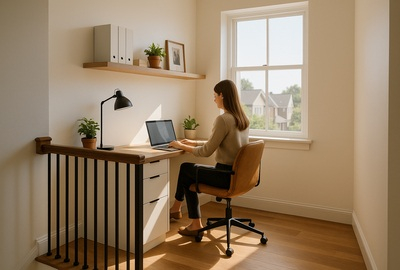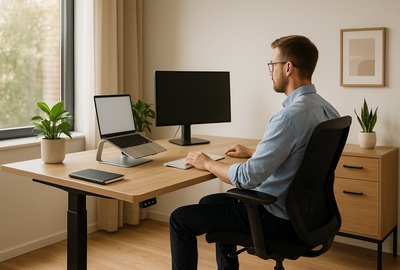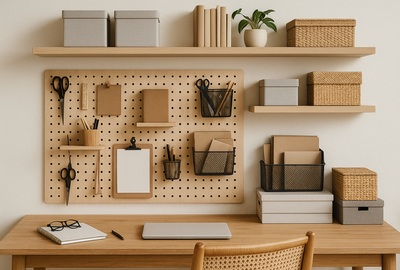- How to Organise Your Home Office: Simple Tips That Work
- 1. How to Organise Your Home Office Without Losing Your Mind
- 2. The Right Tools: From Filing Cabinets to Desk Organization Ideas That Actually Work
- 3. Smart Filing Systems and Open Shelving to Maximise Your Office Space
- 4. Step-by-Step: Decluttering and Handling Important Documents Like a Pro
- 5. Daily Habits for a Clutter Free Home Office That Lasts
- 6. Common Organisation Mistakes That Break Your System Before It Starts
- 7. Add Personality: Create a Home Office Space That Reflects You
- 8. Don’t Wait—Transform Your Workspace and Take Control Today
How to Organise Your Home Office: Simple Tips That Work
Working from home offers flexibility, but without structure, your home office can become a breeding ground for clutter. If you’ve ever spent half your morning looking for a contract or stepping over a pile of papers, you’re not alone. Most people underestimate how much chaos a disorganised workspace creates.
This isn’t just about aesthetics. It's about control. When you learn how to organise your home office, you're taking control of your workflow, your space, and even your mindset. And once that’s in order, productivity naturally follows.
Below are eight clear, proven strategies based on real-life challenges—designed to help you create a clutter free home office that functions as well as it looks.
1. How to Organise Your Home Office Without Losing Your Mind
The phrase "organise your office" sounds simple. But once you start, it’s easy to get stuck. You move a few things around and suddenly you’ve opened a drawer full of tangled cords, receipts, and expired gift cards.
Start small. Grab a trash bag. Don’t overthink. Toss expired papers, broken pens, dried markers, and any material that hasn’t served you in six months.
Next, identify categories: active projects, important documents, essential paperwork, other documents, and keepsakes. Create temporary piles or use trays to group everything logically. Use paper clips to group smaller items or partial documents.
The process of learning how to organise your home office becomes much easier when you eliminate visual overwhelm. And the clarity you gain? Immediate.
2. The Right Tools: From Filing Cabinets to Desk Organization Ideas That Actually Work
To stay organized, you need tools—not just effort. If you’re serious about getting organised, you need storage that works as hard as you do.
- Filing cabinet for storing files, contracts, and documents long-term
- Desk organizers and dividers for pens, paper clips, scissors, and sticky notes
- Vertical space solutions: wall-mounted trays or shelves
- Labeled bins to store items like seasonal paperwork or extra chargers
Don’t let your desk be a dumping ground. Use a catch-all tray or bin and empty it at the end of every day or week.
Also consider syncing your physical setup with your computer—create folders that mirror your file structure to stay digitally tidy too.
3. Smart Filing Systems and Open Shelving to Maximise Your Office Space
A strong filing system doesn’t have to be fancy. Just clear, consistent, and accessible.
- Action items (bills, contracts)
- Archives (tax records, old leases)
- Reference materials (manuals, client info)
Install open shelving above your desk for books, binders, storage boxes, or even a small printer. Use hanging file pockets on the wall for quick access folders. That empty corner? Perfect for a mobile filing cabinet.
4. Step-by-Step: Decluttering and Handling Important Documents Like a Pro
This is where most home offices go off track—paperwork. Whether it's receipts, invoices, or printed forms, paper piles up fast.
- Sort all documents into “Keep,” “File,” and “Shred.”
- File important documents using tabs for fast access.
- Set aside one drawer or box for less urgent papers.
Digital backup is a must. Scan and label documents in your computer, then sync them with cloud storage. If it’s not urgent, it shouldn’t be on the desk.
5. Daily Habits for a Clutter Free Home Office That Lasts
Even the best setup fails without habits. Here’s how to stay organized daily and weekly:
- Reset your desk each morning
- Spend 5 minutes decluttering before you shut down
- File any loose papers immediately after use
If you’ve got kids around, keep sharp or fragile tools in higher shelves or locked drawers—it matters.
Set time each week to review your bulletin board, clear your catch-all tray, and handle shared office supplies with your family member if applicable.
6. Common Organisation Mistakes That Break Your System Before It Starts
You’ve probably tried a system that didn’t stick. That’s because it didn’t fit how you really work.
- Too many steps = unused system
- Ignoring growing clutter
- Decor overpowering functionality
Don’t let pretty baskets fool you. If your materials don’t have a clear home, clutter returns. Simplicity wins every time.
7. Add Personality: Create a Home Office Space That Reflects You
Make your home office space reflect how you want to feel at work—focused, calm, and comfortable.
- Use framed photos, quotes, or a decorative bulletin board
- Add one or two sentimental items for motivation
- Soften the floor with a rug
- Choose lighting and decor that’s aesthetically pleasing
Choose furniture and style that complements your workflow, not just the look of the room. A workspace that feels good will always perform better.
8. Don’t Wait—Transform Your Workspace and Take Control Today
Start with one change: clear your desk, organise one drawer, label your files. Then build momentum.
- Sort your post daily
- Revisit your filing system weekly
- Adjust your space as your needs evolve
No more stress. No more time wasted looking for things. These aren’t just tasks—they’re great tips built from real experience. Simple, practical, and incredibly helpful.
Need help choosing furniture or setting up your workspace? Explore Deskup’s full range of desks, ergonomic chairs, and accessories. Everything’s stocked in Australia and ready to ship.


 Buy Now, Pay Later
Buy Now, Pay Later Verified Rating
Verified Rating 




